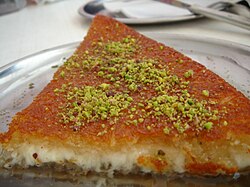 | |
| Alternative names |
|
|---|---|
| Type | Dessert |
| Place of origin | Middle East[1] |
| Region or state | |
| Serving temperature | Warm, room temperature or cold (qishta variety) |
| Main ingredients | |
| Variations | Multiple |
Knafeh[2] (Arabic: كنافة) is a traditional Arabic dessert, made with spun pastry called kataifi,[3][4][5] soaked in a sweet, sugar-based syrup called attar, and typically layered with cheese, or with other ingredients such as clotted cream, pistachio or nuts, depending on the region.[6] It is popular in the Middle East.[7][6][8][9]
In Arabic, the name may refer to the string pastry itself, or to the entire dessert dish. In Turkish, the string pastry is known as tel kadayıf, and the cheese-based dessert that uses it as künefe. In Turkey, it is called künefe.[10] In the Balkans, the shredded dough is similarly known as kadaif/cataif,[11] and in Greece as kadaifi, and is the basis of various dishes rolled or layered with it, including dessert pastries with nuts and sweet syrups.
- ^ Natanel, Katherine (2016). Sustaining Conflict: Apathy and Domination in Israel-Palestine. Univ of California Press. p. 95. ISBN 978-0-520-96079-4.
- ^ "knafeh". dictionary.cambridge.org. Retrieved 2021-08-14.
- ^ "Cheese pastry (künefe)".
- ^ "Tel kadayıf hamuru tarifi". Hurriyet.
- ^ The World Religions Cookbook. Greenwood Press. 2007. p. 158. ISBN 9780313342639.
- ^ a b Davidson, Alan (2014). The Oxford Companion to Food. Oxford University Press. pp. 33, 661–662. ISBN 9780199677337 – via Google Books.
- ^ "Knafeh". Time Out Sydney.
- ^ Edelstein, Sari (2010). Food, Cuisine, and Cultural Competency for Culinary, Hospitality, and Nutrition Professionals. Jones & Bartlett Publishers. ISBN 9781449618117.
- ^ Nasser, Christiane Dabdoub (2013). Classic Palestinian Cuisine. Saqi. ISBN 9780863568794.
- ^ Albala, K. (2011). Food Cultures of the World Encyclopedia. Vol. 1. Greenwood. p. 311. ISBN 9780313376269. Retrieved 2014-12-02.
- ^ Encyclopedia of food and culture. Scribner. 2003. p. 159. OCLC 50590735.